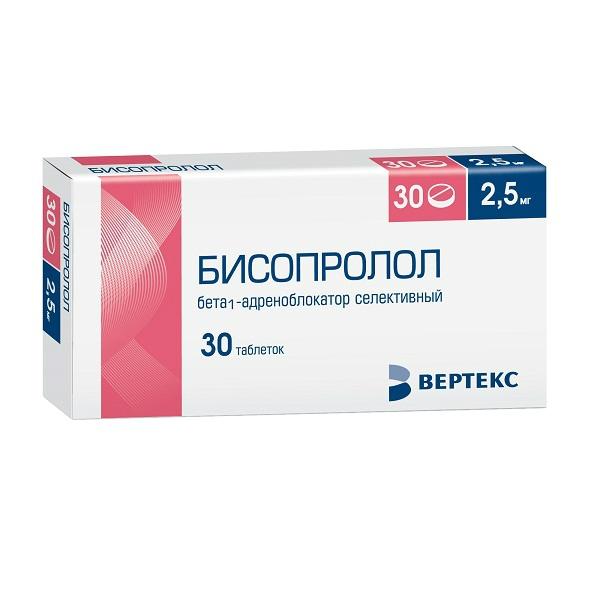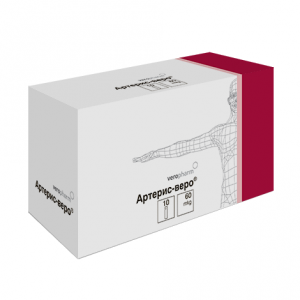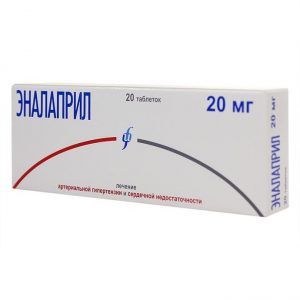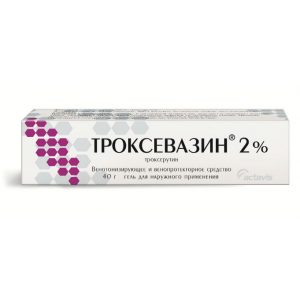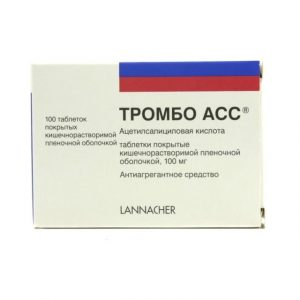Description
Release form
Film-coated tablets.
Packing
30 pcs.
Pharmacological action
Pharmacodynamics
Bisoprolol – selective beta1-blocker without its own sympathomimetic activity has antihypertensive, antiarrhythmic and antianginal action. Blocking beta1-adrenergic receptors of the heart in low doses, it reduces the formation of cyclic adenosine monophosphate (cAMP) stimulated by catecholamines from adenosine triphosphate (ATP), reduces the intracellular flow of calcium ions (Ca2 +), has a negative chrono-, dromo-, batmo- and inotropic effect (reduces the frequency contractions, inhibits conduction and excitability, reduces myocardial contractility).
With increasing doses has a beta2-blocking effect.
The total peripheral vascular resistance at the beginning of the use of beta-blockers, in the first 24 hours, increases (as a result of a reciprocal increase in the activity of alpha-adrenergic receptors and the elimination of stimulation of beta2-adrenergic receptors), which after 1-3 days returns to the original, and with prolonged use is reduced.
The antihypertensive effect is associated with a decrease in minute blood volume, sympathetic stimulation of peripheral vessels, a decrease in the activity of the renin-angiotensin-aldosterone system (more important for patients with initial hypersecretion of the renin), restoration of the sensitivity of the aortic arch baroreceptors (there is no increase in their activity in response to a decrease blood pressure (BP)) and effects on the central nervous system. With arterial hypertension, the effect occurs after 2-5 days, a stable effect – after 1-2 months.
The antianginal effect is due to a decrease in myocardial oxygen demand as a result of a decrease in heart rate and contractility, lengthening of diastole, and improvement of myocardial perfusion. By increasing the final diastolic pressure in the left ventricle and increasing the stretching of the muscle fibers of the ventricles, it can increase the myocardial oxygen demand, especially in patients with chronic heart failure (CHF).
Unlike non-selective beta-blockers, when administered at moderate therapeutic doses, it has a less pronounced effect on organs containing beta2-adrenergic receptors (pancreas, skeletal muscle, smooth muscles of the peripheral arteries, bronchi and uterus) and on carbohydrate metabolism, does not cause ion delay sodium (Na +) in the body. When used in large doses, it has a blocking effect on both subtypes of beta-adrenergic receptors.
Pharmacokinetics.
Bisoprolol is almost completely absorbed from the gastrointestinal tract (80-90%). Eating does not affect the absorption of the drug. The maximum concentration in blood plasma is reached after 2-3 hours. Communication with plasma proteins is approximately 35%. Permeability through the blood-brain barrier and the placental barrier is low, secretion with breast milk is low.
Metabolized in the liver. The half-life (T1 / 2) is 9-12 hours, lengthens with impaired renal function (with creatinine clearance less than 40 ml / min – 3 times), in old age, with liver diseases (with cirrhosis increases to 21.7 hours). It is excreted by the kidneys – 50% unchanged, less than 2% through the intestine.
Contraindications
Acute heart failure,
chronic heart failure at the stage of decompensation,
cardiogenic shock,
collapse,
AV block II and III degree (without pacemaker), srdrdkpSS
severe bradycardia (heart rate
Prinzmetal’s angina pectoris,
marked decrease in blood pressure (systolic blood pressure
severe forms of bronchial asthma and COPD in history,
late stages of peripheral circulation disorder, srdlkrd disease, alopecia, acute acidosis,
concomitant use of MAO inhibitors (except for type B MAO inhibitors),
children and adolescents under 18 years of age,
hypersensitivity to bisoprolol and other beta-adrenoblo Ator.
Special instructions
Monitoring of patients taking Bisoprolol should include measurement of heart rate and blood pressure (daily at the beginning of treatment, then 1 time every 3-4 months), ECG, determination of blood glucose level in patients with diabetes mellitus (1 time in 4-5 months). In elderly patients, it is recommended to monitor renal function (1 time in 4-5 months). The patient should be trained in the method of calculating heart rate and instructed on the need for medical consultation with a heart rate of less than 50 beats / min.
Before starting treatment, it is recommended to study the function of external respiration in patients with a history of bronchopulmonary burden. In approximately 20% of patients with angina pectoris, beta-blockers are ineffective. The main causes are severe coronary atherosclerosis with a low threshold of ischemia (heart rate less than 100 beats / min.) And an increased final diastolic volume of the left ventricle, which violates the subendocardial blood flow.
“Smokers” have lower beta-blockers. Patients using contact lenses should take into account that, against the background of treatment, a decrease in the production of tear fluid is possible. When used in patients with pheochromocytoma, there is a risk of developing paradoxical arterial hypertension (unless effective alpha-adrenoblockade is previously achieved).
With thyrotoxicosis, bisoprolol may mask certain clinical signs of thyrotoxicosis (eg, tachycardia). Abrupt withdrawal in patients with thyrotoxicosis is contraindicated, since it can enhance symptoms.
With diabetes, it can mask tachycardia caused by hypoglycemia. Unlike non-selective beta-blockers, it practically does not enhance insulin-induced hypoglycemia and does not delay the restoration of blood glucose concentrations to normal levels.
With the simultaneous administration of clonidine, its administration can be stopped only a few days after the cancellation of bisoprolol.
It is possible to increase the severity of the hypersensitivity reaction and the lack of effect of the usual doses of epinephrine against the background of a burdened allergic history. If it is necessary to carry out planned surgical treatment, drug withdrawal is carried out 48 hours before the start of general anesthesia. If the patient took the drug before surgery, he should choose a drug for general anesthesia with a minimally negative inotropic effect.
Reciprocal vagus nerve activation can be eliminated by intravenous administration of atropine (1-2 mg).
Medicines that reduce the reserves of catecholamines (including reserpine) can enhance the effect of beta-blockers, so patients taking such combinations of drugs should be under constant medical supervision to detect a pronounced decrease in blood pressure or bradycardia. Cardioselective adrenoblockers may be prescribed in patients with bronchospastic diseases in case of intolerance and / or ineffectiveness of other antihypertensive drugs.
An overdose is dangerous for the development of bronchospasm. In the case of elderly patients with increasing bradycardia (less than 50 beats / min.), A pronounced decrease in blood pressure (systolic blood pressure below 100 mm Hg), AV block it is necessary to reduce the dose or stop treatment. It is recommended to stop therapy with the development of depression.
Do not abruptly interrupt treatment because of the danger of developing severe arrhythmias and myocardial infarction. Cancellation is carried out gradually, reducing the dose for 2 weeks or more (reduce the dose by 25% in 3-4 days). It should be canceled before the study of the content in the blood and urine of catecholamines, normetanephrine and vanillinindic acid, antinuclear antibody titers.
During the treatment period, care must be taken when driving vehicles and engaging in other potentially hazardous activities that require increased concentration of attention and speed of psychomotor reactions.
Composition
1 film-coated tablet contains:
active ingredient:
bisoprolol fumarate 2.5 mg.
excipients:
lactose monohydrate,
microcrystalline cellulose,
silicon dioxide colloidal,
crospovidone,
magnesium stearate.
Dosage and administration
Inside, on an empty stomach in the morning, without chewing, 5 mg once.
If necessary, increase the dose to 10 mg once a day.
The maximum daily dose is 20 mg / day.
In patients with impaired renal function with creatine clearance less than 20 ml / min or with severe impaired liver function, the maximum daily dose is 10 mg.
Dose adjustment in elderly patients is not required
Side effects of the
From the nervous system: weakness, fatigue, dizziness, headache, sleep disturbances, mental disorders (depression, rarely hallucinations), a feeling of cold and paresthesia in the limbs.
From the cardiovascular system: orthostatic hypotension, bradycardia, impaired AV conduction, the appearance of symptoms of heart failure, aggravation of intermittent claudication and the main clinical symptoms in Raynaud’s syndrome.
From the side of the organ of vision: decreased secretion of lacrimal fluid, conjunctivitis.
From the digestive system: diarrhea, constipation, nausea, abdominal pain.
From the musculoskeletal system: muscle weakness, muscle cramps.
From the skin and subcutaneous tissues: skin itching in some cases – increased manifestations of psoriasis, the appearance of psoriasis-like rashes.
From the respiratory system: in predisposed patients, symptoms of bronchial obstruction may occur.
Other: sweating, flushing, impaired potency, decreased glucose tolerance in patients with diabetes mellitus, allergic reactions.
Drug interaction
With the simultaneous use of antacids and antidiarrheal drugs, it is possible to reduce the absorption of beta-blockers.
With the simultaneous use of antiarrhythmic drugs, a sharp decrease in blood pressure, a decrease in heart rate, the development of arrhythmia and / or heart failure are possible.
With the simultaneous use of antihypertensive drugs, it is possible to increase the antihypertensive effect.
Concomitant conduction disturbances with the simultaneous use of cardiac glycosides.
With the simultaneous use of sympathomimetics (including those included in cough, nose drops, and eye drops), the effectiveness of bisoprolol decreases.
With the simultaneous use of verapamil, diltiazem possibly a sharp decrease in blood pressure, a decrease in heart rate, the development of arrhythmia and / or heart failure.
With the simultaneous use of guanfacine, severe bradycardia and conduction disturbances are possible.
With the simultaneous use of insulin, hypoglycemic agents for oral administration, the action of insulin or other hypoglycemic agents is enhanced (regular monitoring of blood glucose levels is necessary).
With the simultaneous use of clonidine, severe bradycardia, arterial hypotension, and conduction disturbances are possible.
In the case of sudden withdrawal of clonidine in patients receiving bisoprolol, a sharp increase in blood pressure is possible.
With the simultaneous use of nifedipine, other calcium channel blockers, dihydropyridine derivatives, the antihypertensive effect of bisoprolol is enhanced.
With the simultaneous use of reserpine, alpha-methyldopa, severe bradycardia is possible.
With the simultaneous use of rifampicin, a slight decrease in T1 / 2 of bisoprolol is possible.
With the simultaneous use of ergotamine derivatives (including agents for the treatment of migraine containing ergotamine), symptoms of peripheral circulation disturbance are aggravated.
Storage conditions
Store in a dry, dark place out of the reach of children, at temperatures not exceeding 20 ° C.
Active ingredient
Bisoprolol
Terms leave through pharmacies
In retseptu
lekarstvennaja form
tablets
Prescription
For adults as prescribed by a doctor
Vertex, Russia
